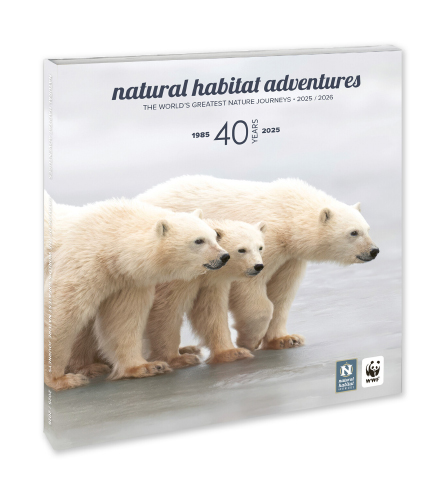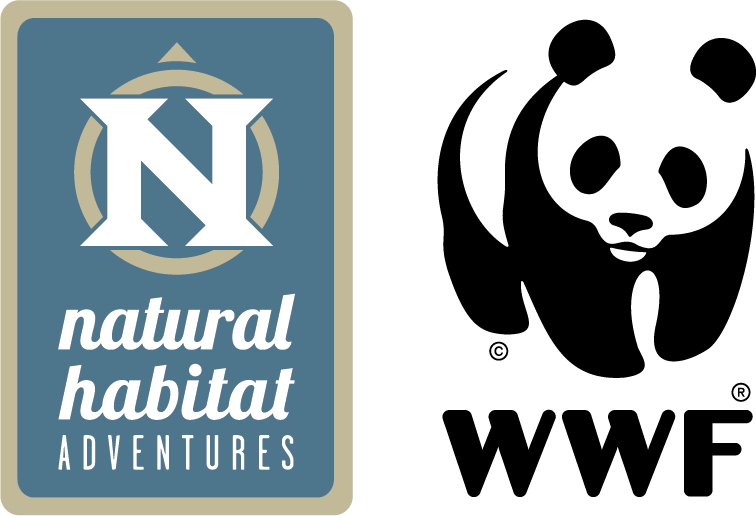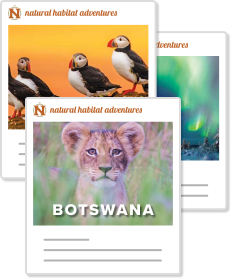Have you ever seen a greater short-horned lizard scrape its crown of spines along a canyon rim? Smelled the fresh spray of a cascading spring? Heard the love songs of a northern pygmy-owl duet? Or, perhaps, whispers through the breeze—from the Navajo sedge plants growing in seeps and hanging gardens?
Imagine shimmering layers of sandstone and limestone, carved by eons of abrasive wind and water; rock spires that pierce the sky, vying for spotlight alongside soaring golden eagles; and multi-hued monoliths that glow brilliant red, pink and violet with the rising and setting sun.
The Canyonlands of the Southwest are natural amphitheaters. Cavernous escarpments, punctuated by pinnacles that tower above snaking canyons hundreds of feet below, amplify the bioacoustics of these desert worlds.
Ready to discover the desert secrets of the Southwestern United States? Learn more about our Moab, Arches & Canyonlands Escape and our Grand Canyon, Bryce & Zion adventure!
Sights, Scents and Soundscapes
The concerto commences with atmospheric electricity as prickly as the saguaro cactus. A flash of lightning illuminates the canyon cliffs, and the call of a mountain lion (puma) reverberates off the sheer walls. The echo succumbs to a crescendo of thunder, followed by torrential rains that pound the scorched earth. Then, as suddenly as the storm appeared, it is lost to the night.
A moment’s breath…a cacophony of frogs in their riparian oases flood the silence. Finally, with its shaking snare, a rattlesnake cues a black tarantula to leave its silk-lined burrow for a hunt by unpolluted starlight.

© Court Whelan
This dramatic display has revealed just a few of the secrets told by the deserts of the American Southwest, and there are many more—if you look and listen closely.
Flora
Deserts represent some of the most formidable environments in the world. Utah’s Bryce Canyon experiences temperature fluctuations above and below freezing in the same night—more than half of the days of the year (170 to be exact). Therefore, it comes as no surprise that Bryce is home to some of the most adaptable and resilient plant and animal communities on the planet. To endure, or even thrive in these volatile conditions, native species rely on their resourcefulness in landscapes seemingly devoid of resources.
Upon first glance—or even first visit to a desert environment in the United States, the landscape may appear sparsely populated, with vegetation only sporadically available. However, variations in the topography are as striking as the region’s climatic extremes. An hour’s hike in Arizona or Utah reveals a significant change in geography with the rounding of each bend.
Trees
The American Southwest is sprinkled with more than 100 million acres of pinyon pine and juniper forests. This biome comprises approximately 15% of the land area in five states—Arizona, Colorado, Nevada, New Mexico, and Utah.
Though pinyon-juniper woodlands provide an abundance of ecosystem services—from wildlife habitat to vegetative coverage for watershed protection—they are among the least-studied North American forest types.
Cacti and Other Plants
Several rare and at-risk biota in the Southwest have a limited range due to freezing temperatures, frost sensitivity and high elevation. The plants are also vulnerable to anthropogenic threats such as habitat loss and the introduction of exotic and invasive species.
The saguaro cactus, for example, only grows in the Sonoran desert. Despite its ecological niche, the saguaro services just about every organism in its vicinity. Small birds excavate nest cavities inside, while large ones build stick nests along its arms. The flowers, fruit and flesh provide moisture and nutrients for birds, mammals and reptiles, in addition to nectar for pollinators from insects to bats. The Tohono O’odham peoples of Arizona consider the saguaro a sacred plant and use it for both ceremony and subsistence. A fully grown saguaro can grow to 40 feet tall!
At the other end of the size spectrum, at just 4 inches tall, is the Jones cycladenia. This perennial herb is characterized by tufted bunches of bright-green rounded leaves and pink trumpet-shaped flowers, which resemble miniature morning glories. Though found among mixed desert shrub, juniper or wild buckwheat, the cycladenia requires a very specific set of soil conditions to survive.
Unfortunately, the ecosystem where this plant grows is fragile and easily degraded. Off-road vehicles, foot traffic and the exploitation of the land for oil, gas and minerals further threaten this already critically imperiled species. If you come across this unique herb, consider yourself very lucky. Keep its location a secret, however, as the last thing this wild beauty needs is to become a coveted collector’s item.
Fauna
The American Southwest comprises some of the country’s greatest diversity of mammal species. With approximately 643 species in temperate North America, most of these animals don’t suffer from a scarcity of sustenance, but rather a lack of documentation.
Just as mammals in the Greater Yellowstone Ecosystem contend with social and political boundaries, desert animals in the Southwest are subject to varying management policies and land use practices. Coupled with the elusive nature of most desert-dwelling species, surveying behavior, population and distribution is a challenge.

© Jeremy Covert
Arizona’s Grand Canyon National Park supports more than 1,500 plant, 355 bird, 89 mammalian, 47 reptile, 17 fish and 9 amphibian species throughout several major ecosystems. Its biodiversity is owed to the presence of five of the seven life zones (Lower Sonoran, Upper Sonoran, Transition, Canadian, and Hudsonian) and three of the four desert types in North America.
Scientists from the U.S. Geological Survey collaborated with university scientists in Arizona and New Mexico to model the effects of climate change on 12 southwestern bird and reptile species. The project revealed that five bird species face predicted range losses.
Consequently, the Williamson’s sapsucker and the pygmy nuthatch will inch toward extinction within the next century. Of the five reptile species analyzed, three are predicted to lose over 40% of their ranges: plateau striped whiptail, Arizona black rattlesnake, and the lesser earless lizard.
Hidden Treasures of Prehistoric Cultures
Embedded within the rainbow rivulets of limestone and sandstone is an equally colorful human history. Geological striations, which seem to be painted into the landscape by giant brushstrokes, illustrate 13,000 years of vibrant Native American culture.
The earliest people lived during the late Pleistocene period, when megafauna such as mammoths dominated the region. Next, the Paleoindian period, which began approximately 11,500 years ago, was marked by the occupation of nomadic groups who gathered wild plants and hunted mountain goats, ground sloths and bison. The Ancestral Puebloan people of Grand Canyon left behind dwellings, agricultural sites and precious artifacts, which have provided archaeologists insight into a long-lost past.
Troves of ancient relics are buried in relatively inaccessible and abandoned cave systems in the Great Basin and on the Colorado Plateau. In 1933, a discovery was made in the Grand Canyon: split-twig figurines dating back 2,000–4,000 years. Constructed from a single willow twig split down the center and then delicately sculpted, the Indigenous artists formed animals such as deer and bighorn sheep, equipped with antlers and horns. Occasionally, they stuffed the figures with artiodactyl dung or pierced them with sticks representing spears.
While the split-twig figurine function is rather mysterious, their meticulous placement under rock cairns implies they were totems associated with the Late Archaic hunting and gathering culture.
Mystical Powers of Bryce’s Hoodoos
No one interprets the stories and secrets of the desert as well as the Southern Paiute, Hopi, Zuni, Ute and Navajo peoples of the Southwestern United States. Bryce Canyon National Park is steeped in mysticism and spiritual wonder.

Bryce Canyon National Park © Melissa Scott
The Paiute peoples who occupied Bryce Canyon as early as 1200 A.D. considered the park’s famous rock towers—today known as hoodoos—to be the petrified remains of ancient beings. Their legend was conveyed to a park naturalist in 1936 by Indian Dick, a Paiute elder who lived on the Kaibab Reservation:
“Before there were humans, the Legend People, To-when-an-ung-wa, lived in that place. There were many of them. They were of many kinds—birds, animals, lizards and such things, but they looked like people. They were not people. They had power to make themselves look that way. For some reason the Legend People in that place were bad; they did something that was not good, perhaps a fight, perhaps some stole something….the tale is not clear at this point.”
Because they were bad, Coyote turned them all into rocks. You can see them in that place now all turned into rocks; some standing in rows, some sitting down, some holding onto others. You can see their faces, with paint on them just as they were before they became rocks. The name of that place is Angka-ku-wass-a-wits (red-painted faces). This is the story the people tell.”
Colonial History of the Hoodoos
It was English settlers who eventually branded the formations “hoodoos.” The etymology has roots as deep as the structures are tall. The name derives from the Hoodoo spirituality—a religious tradition introduced to the United States during the transatlantic slave trade. Inspired by Central and West African practices, Hoodoo was an amalgam of “conjure” and “Voudoo,” used to describe natural forms that possessed other-worldly powers.
Of course, geologically, Bryce Canyon’s hoodoos were formed through rock deposition and uplift, then chiseled over 50 million years by weathering and erosion. Bryce boasts the largest assemblage of hoodoos in the world. attracting millions of visitors to the park every year!
Protecting Bryce Canyon’s Hoodoos
Unfortunately, hoodoo allure is only enhanced by the fleeting nature of its existence. The average rate of erosion is calculated at 2-4 feet every 100 years. Walking up to the base of a hoodoo weakens the clay slopes that protect its foundation—dramatically shortening its lifespan. Reminiscent of a slow-burning candle, or the drippy sand castles children make at the beach, anthropogenic forces will inevitably erase them from the landscape…a slow ebb, but an exodus nonetheless.
Though Bryce Canyon as we know it will one day cease to exist, we can prevent further erosion and preserve hoodoo longevity by keeping to designated trail systems. For those who wish to view the hoodoos in all their glory, we offer a scenic helicopter flight as part of our Grand Canyon, Bryce & Zion adventure. This exclusive opportunity grants guests a bird’s-eye view of the landscape that will rival that of a peregrine falcon.

© Court Whelan
Ephemeral Waters of the Grand Canyon
Although the Colorado River flows through the Grand Canyon’s very heart, the true lifeblood originates from the landscape’s native waterways. Seeps and springs may make up less than 0.01% of the Grand Canyon, but these hydrogeological features saturate an otherwise arid environment—providing drinking water to wildlife, offering refuge to terrestrial species, and maintaining critical riparian habitats.
Each seep and spring supports a distinct array of flora and fauna, many of which are endemic to the region. Species concentrations are 500 times greater at the springs than in surrounding areas. Researchers have discovered that canyon floor springs support ephemeral and regenerative biology due to flash flood events. In contrast, hillside springs, which are protected from such violence, provide the stability needed for the evolution of new species. For example, two South Rim springs nurture the only known white-flowering redbud trees.
Environmental Threats to the Colorado River and the Grand Canyon
As drought and climate change exacerbate water quantity and quality issues, resource management will increase in legal, social, and ecological importance for Grand Canyon National Park and much of the Southwest. Whether replenishing belted kingfishers or the eleven Native Tribes from Arizona, Nevada, Utah and New Mexico—protecting the cerulean waters of their Canyon homeland is crucial. When the springs and tributaries dry up, so do the lifeways that depend on them.
The Grand Canyon is regarded as one of the Seven Natural Wonders of the World. In the spirit of Indigenous storytelling, this site of geological phenomenon—and the desert secrets within—should be passed down to future generations to encourage sustainable stewardship of the Southwest.
Your journey into the prehistoric past begins along the rim of the Grand Canyon, where Nat Hab’s own Emily Goodheart muses:
“Gazing upon this natural marvel as the purple shadows of twilight descend and a fiery sun melts into a starry night is nothing short of spectacular.”
Explore the Southwest on Nat Hab’s 8-day Grand Canyon, Bryce & Zion adventure or on our 5-day Moab, Arches & Canyonlands Escape!



























